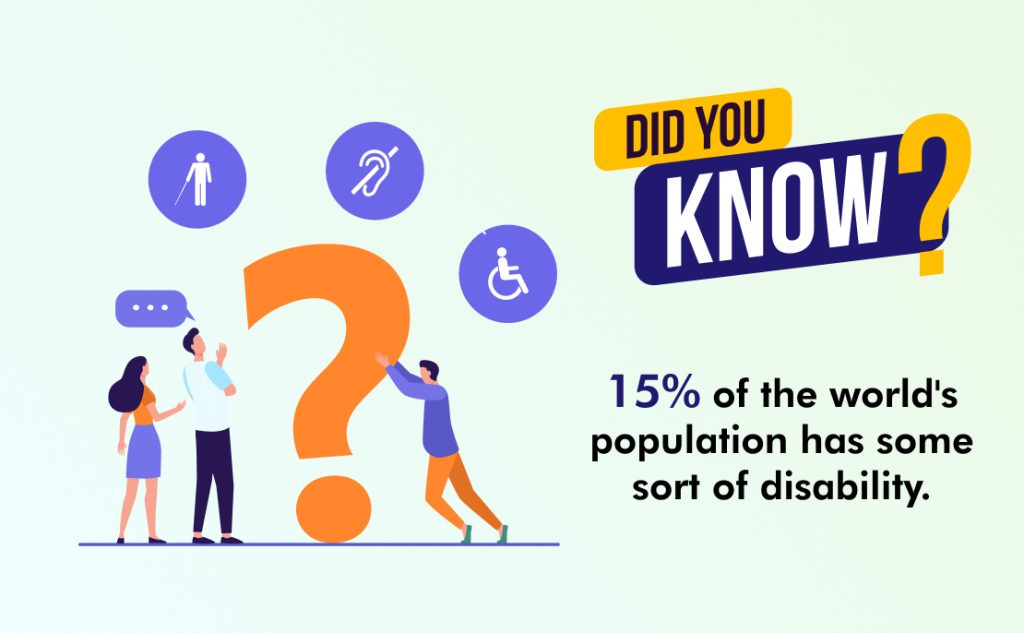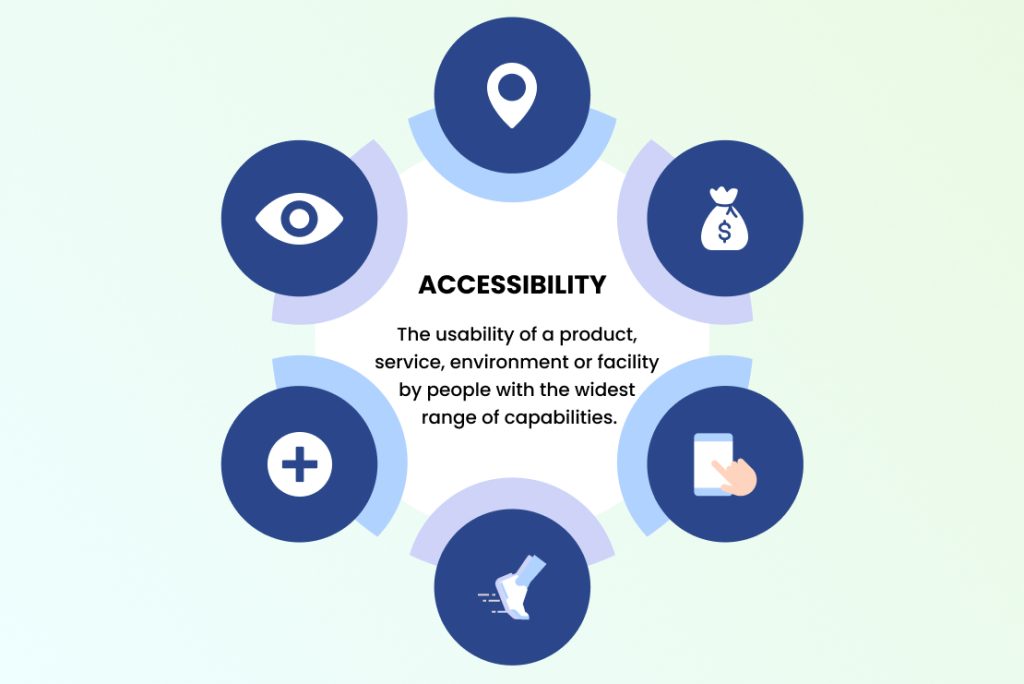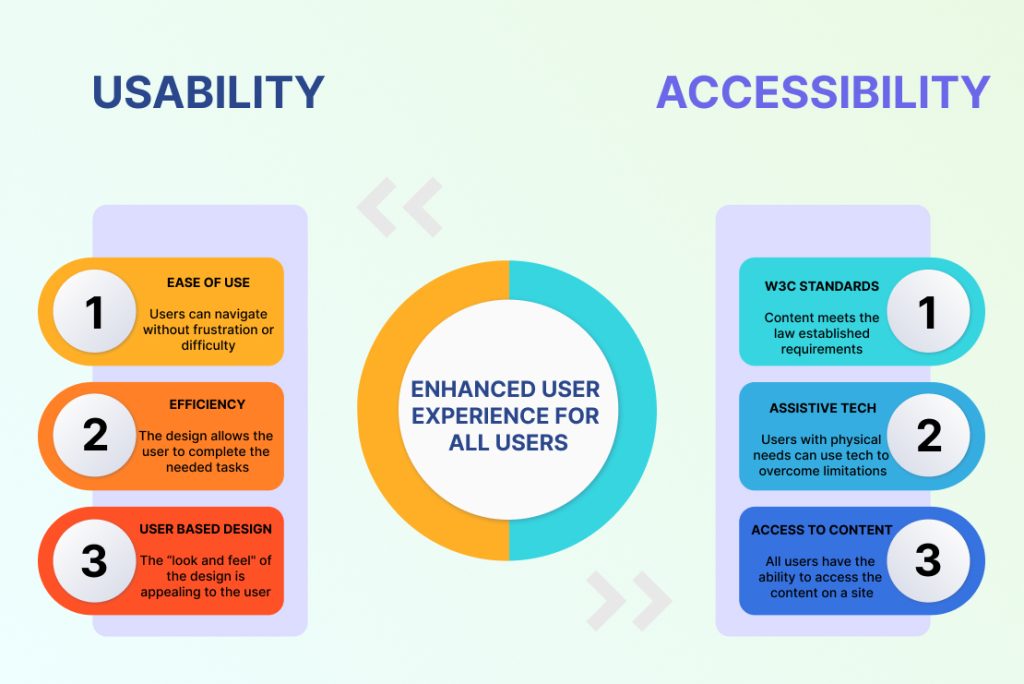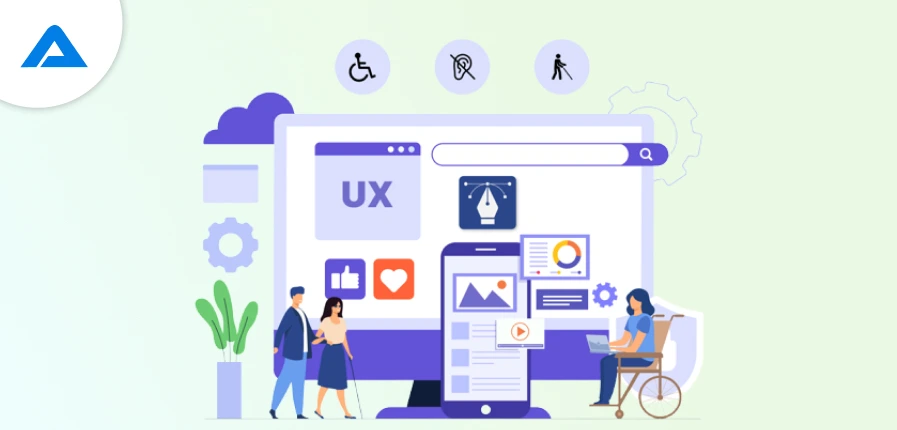As a business, designing an accessible website is essential for companies to impress users and deliver the best user experience. It helps businesses reach new audiences and build a world where technology and digital services are accessible to people with disabilities.
Did you know that over 15% of the population of the world has a disability? This makes it extremely important for your business to consider accessibility without fail when developing your app, website, or other digital assets. Therefore, If you want to build your business website or revamp the same, it is high time you consider including accessibility in user experience design.

You can enjoy a variety of advantages by taking care of user accessibility and making it an essential part of your website’s overall user experience. Whether you are a CEO, business owner, startup founder, CFO, or part of an agency, understanding the importance of accessibility design will help you build inclusive and successful digital products.
Having worked as a UI design agency for numerous years, AddWeb Solution has a defined process to make our clients’ apps, websites, and other online assets accessible to everyone. Let’s explore the concept of designing for UX accessibility and its significance in creating enhanced user experiences.
What Is Designing for UX Accessibility?
Designing for UX accessibility is about creating digital services and products accessible to people with different disabilities. They are people with vision impairments, mobile limitations, hearing issues, etc.
By designing websites or other digital assets that are accessible to people with disabilities, you are building an inclusive online world. The primary objective of doing this is to ensure that users, irrespective of their abilities, can use, interact with, and understand websites and apps.
The advantages of doing so are numerous for businesses, which we will discuss briefly.
Interactions with Digital Interfaces
In today’s digital age, we interact with various digital interfaces daily. From websites to mobile apps, from e-commerce platforms to social media networks, our lives are heavily influenced by technology.
However, not everyone interacts with digital interfaces in the same way. Individuals with disabilities often face barriers that hinder their ability to engage with digital content fully. As per WebAIM, 97.4% of all top websites and apps have accessibility issues.
This creates a massive challenge for people with disabilities to take advantage of the technology-driven world that we live in. In addition, they are also left out of the limelight. That’s also why many countries have made accessibility a legal requirement for businesses.
By designing for accessibility, we can remove these barriers and provide an inclusive experience for all users.
Related Article: 6 Proven Tips for Your Website Accessibility
What Is Website UX Accessibility?
In simpler words, website UX accessibility is all about designing websites accommodating users with disabilities. Some of the common techniques used for the same are:
- Color contrast
- Text alternatives for images
- Keyboard navigation
- Clear and concise content
- Compatibility with assistive technologies
- Text-to-speech capabilities
When a website has higher user accessibility, it allows individuals with disabilities to perceive, understand, navigate, and interact with the content effectively.

5 Ways to Create Enhanced User Experiences with Accessibility
Having understood what website UX accessibility is, we will discuss how to create better user experiences for everyone by making it accessible to all.
Adding accessibility menus
Implementing accessibility menus is an effective way to enhance user experiences with accessibility. Website visitors can use these menus and customize their experience based on their specific accessibility needs.
This is important as accessing websites becomes highly personal with such options. For example, users may adjust font sizes, enable high contrast mode, or activate screen readers when the website has such accessibility options.
By giving users control over their experience, we empower them to tailor the interface to their preferences and abilities.
Understanding usability vs. accessibility
Many businesses consider usability and accessibility to be the same. While they are closely related, they are not the same thing.
Usability focuses on how easily and efficiently users can accomplish their goals within a digital interface. On the other hand, accessibility is about ensuring that all users can access and use the interface, regardless of their abilities. Understanding the distinction between these two allows you to design inclusive experiences for all users.
Hence, next time you are designing your website, consider both usability and accessibility to create interfaces that are usable and accessible to a wide range of users.

Usability focuses on how easily and efficiently users can accomplish their goals within a digital interface. On the other hand, accessibility is about ensuring that all users can access and use the interface, regardless of their abilities. Understanding the distinction between these two allows you to design inclusive experiences for all users.
Hence, next time you are designing your website, consider both usability and accessibility to create interfaces that are usable and accessible to a wide range of users.
Humanize the design of digital assets.
If we want to create genuinely inclusive experiences, we need to go beyond meeting the technical requirements of accessibility standards.
The focus must be on humanizing design by considering the unique needs, preferences, and challenges of individuals with disabilities. This is a rather challenging task as it involves extensive user research, and you can:
- Help the design team to understand how people with disabilities use the web and the challenges they face.
- Gathering feedback from users with disabilities
- Incorporate people with such disabilities into the design process, understand their perspective, etc.
However, the benefits of doing this are many. We can create empathetic, intuitive, and inclusive interfaces by putting people at the center of our design decisions.
Explain and educate the UX design team.
Whether you have an in-house team or a third-party vendor to design your website, accessibility should be a priority for your entire UX team. You must provide training and education on accessibility best practices, guidelines, and assistive technologies.
Equipping your team with the necessary knowledge and skills is the best way to ensure that accessibility is considered at every stage of the design and development process.
The teams must also be aware of various legal requirements regarding accessibility, such as:
- 21st Century Communications and Video Accessibility Act (CVA)
- Web Content Accessibility Guidelines (WCAG)
- Section 508 standards of the Rehabilitation Act
- Americans with Disabilities Act (ADA)
This proactive approach is what you need to create more accessible and inclusive digital products, which can further lead to creating a more welcoming, accessible digital world.
Research the industry and audience thoroughly
The field of accessibility design is constantly evolving, with new technologies, techniques, and best practices emerging regularly. As a business, you must stay informed and up to date with the latest advancements in accessibility to deliver the most accessible UX designs to your audience.
You can take diverse actions to do it, such as engaging in ongoing research, attending conferences and webinars, and connecting with accessibility experts and communities.
You can continue to improve your accessibility practices and deliver better user experiences when you are constantly in touch with the industry and the developments happening concerning accessibility.
Related Article: The Most Common Website Redesign Blunders You Should Avoid
Designing and Developing with Empathy
There is no doubt that at the core of accessibility design is empathy, which every UI/UX design company must understand.
UX professionals have the power to make a positive impact on people’s lives by creating digital experiences that are inclusive, empowering, and delightful. But as a business, you must inspire and guide them to do it.
When you design and develop your website with empathy, you are contributing to breaking down barriers, promoting equality, and ensuring that everyone has equal access to information and opportunities.
That’s the kind of inclusive world we all must strive to build, and your website must be inclusive so that you inspire others to follow suit.
Conclusion
Designing for accessibility is about compliance with regulations and creating inclusive and meaningful experiences for all users. You can unlock new possibilities and tap into a more extensive user base by considering the needs of individuals with disabilities.
Whether you are a CEO, business owner, startup founder, CFO, or part of an agency, incorporating accessibility into your UX design process is a wise investment that benefits your users and your business. You must strive to enhance user experiences by prioritizing accessibility in our digital products.
However, designing the UX without the help of a professional UI/UX design company is hard. And if you are searching for a reliable UI design agency, AddWeb Solution is the best. Having worked with many international and local businesses designing user experiences, we can help you.
Talk to our client support team to hire UI/UX designers and create the most immersive and accessible UX experience for all.
